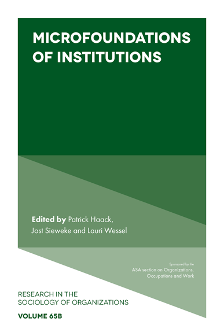
Index
Microfoundations of Institutions
ISBN: 978-1-78769-128-5, eISBN: 978-1-78769-127-8
ISSN: 0733-558X
Publication date: 25 November 2019
Citation
(2019), "Index", Haack, P., Sieweke, J. and Wessel, L. (Ed.) Microfoundations of Institutions (Research in the Sociology of Organizations, Vol. 65B), Emerald Publishing Limited, Leeds, pp. 429-442. https://doi.org/10.1108/S0733-558X2019000065B035
Publisher
:Emerald Publishing Limited
Copyright © 2020 Emerald Publishing Limited
INDEX
Note: Page numbers followed by “n” with numbers indicate notes.
- Prelims
- Section 4: Communicative Perspective on Microfoundations
- Chapter 1: Arguments and Institutions
- Chapter 2: Rituals of Critique and Institutional Maintenance at the United Nations Climate Change Summits
- Chapter 3: Framing Fairness: Microfoundations of the Moral Legitimacy of Alberta’s Oil Sands
- Chapter 4: From Cruise Director to Rabbi: Authoring the Agentic Self through Conventions of Narrative Necessity
- Chapter 5: Melting Icebergs vs. Spectacularization: Storytelling of Conflicting Institutional Demands in Wildlife Documentaries
- Chapter 6: Microfoundations and Recursive Analysis: A Mixed-Methods Framework for Language-Based Research, Computational Methods, and Theory Development
- Section 5: Behavioural Perspective on Microfoundations
- Chapter 7: Practicing Capitals Across Fields: Extending Bourdieu to Study Inter-Field Dynamics
- Chapter 8: “Navigation Techniques”: How Ordinary Participants Orient Themselves in Scrambled Institutions
- Chapter 9: Institutional Entrepreneurs’ Skills: A Multi-Dimensional Concept
- Chapter 10: Situating Frames and Institutional Logics: The Social Situation as a Key Institutional MicroFoundation
- Chapter 11: Institutionalizing Place: Materiality and Meaning in Boston’s North End
- Chapter 12: Hybridity and Power in the MicroFoundations of Professional Work
- Chapter 13: Outsourcing Public Services: A Multilevel Model of Leadership-Driven Gradual Institutional Change of Public Services Provision
- Chapter 14: Creating the British Academic Health Science Centres: Understanding the Microfoundations of the Translation of Organizational Forms
- Section 6: Reflections on Microfoundations
- Chapter 15: Conceptual Metaphors in MicroFoundations of Institutional Theory
- Chapter 16: Bringing Society Back in Again: The Importance of Social Interaction in an Inhabited Institutionalism
- Chapter 17: What Do We Talk about When We Talk about Microfoundations? Conceptualizations of Actor and Multi-Level Accounts of the Micro in Institutional Processes
- Chapter 18: Why Worry? Celebrating and Reformulating “Integrative Institutionalism”
- Chapter 19: Towards a Theory of Micro-Institutional Processes: Forgotten Roots, Links to Social-Psychological Research, and New Ideas
- Section 7: Epilogues
- Chapter 20: Microfoundations for Institutional Theory?
- Chapter 21: The Social Construction of the “Micro-Social”
- Chapter 22: Institutions on the Ground
- Index